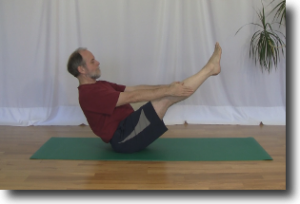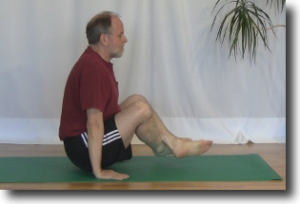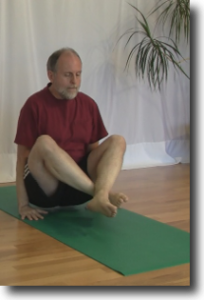The rocket lifted off briefly and then fell over. The next rocket did not even get off the ground. There were a lot of rocket launches that failed in the early days of space flight according to the documentary that Alice was watching.
Over time as they got better at building them the rocket launches got easier and easier.
“The lift off between Navasana is much the same.” thought Alice “At first it was really hard, but over time it got easier and easier.”
What is Navasana
Navasana is one of the seated pose that occurs in the middle of the Primary Series of Ashtanga Yoga.
There are several benefits to practising Navasana including:
- Strengthening the muscles of the abdomen, hip flexors, and spine
- Stimulating the kidneys, thyroid, prostate glands, and intestines
- Helping to relieve stress
- Improving digestion
Navasana is a relatively easy pose to accomplish since there is no binding or twisting in the pose.
How to do Navasana
You start in Dandasana, seated on the floor with your legs together and straight out in front of you.
Next you start exhaling and you lift your arms up parallel to the floor with your palms facing each other.
Then you lean your torso back to about 45 degrees and lift your legs up between your hands.
Now you gaze towards your toes and hold here for five or more breaths.
There should be just enough space between your hands for your legs to fit between them and your feet should be about the same height as your head.
One of the unique things about Navasana is that it is repeated five times in a row in the Ashtanga Yoga Primary Series. After you do the pose you lift your body off of the ground. While it looks easy to do it can be quite challenging to achieve lift off as Alice found out when she first started to do the pose.
How to lift off
After holding for five breaths in Navasana you bring your hands to the floor beside your hips. You spread your fingers wide and flatten your palms to the floor. This will give a firm and stable foundation.
While inhaling you lift your torso up, taking your hips off of the floor. Next you lift your knees up and take your feet off of the floor as well. Eventually you will move yours hips back and up into Lollasana where your hips are approaching the height of your shoulders.
While you are lifting off you hold your gaze on the horizon.
You hold here suspended in the air with just your hands on the floor and then with an exhale you lower down to the floor.
The lift off between each Navasana pose while it is simple to do has several benefits.
Why lift off
Each time Alice lifts off she is developing her strength in her upper body. Her back, shoulder and abdominal muscles are getting stronger.
Lifting your hips off of the floor requires strength and mobility in your back and shoulders. Lifting your knees and feet off of the floor requires considerable strength in your abdominal muscles and your quadriceps.
Each time you lift off you are developing the ability to do a vinyasa as well which is the connecting movement between many of the seated postures in Ashtanga Yoga.
There are three mistakes to avoid when lifting off in Navasana:
– Your hands are off of the floor
– Your hands are in the wrong place
– You are bouncing.
While this is a simple action and there is no binding nor twisting in this pose there are still lots of areas where you can make some mistakes.
Mistakes to avoid
Your Hands are off of the floor
The most common problem with the lift off is that you can not get your hands on the floor. Most believe that their arms are too short compared to their torso. This problem has more to do with their lifestyle and less to do with the length of their arms. Sitting and working at a desk most of the day results in your shoulders lifting up towards your ears. This pose works to counteract this tendency.
The second problem is that you get your hands to the floor but in order to achieve lift off you keep your wrists off of the floor and just have the top of your palms and fingers on the floor. You can potentially injure your wrists in this position.
To avoid these two problems you need to get your hands flat to the floor beside your hips.
Bend over and round your back enough so that your hands come completely to the floor. Once you have your hands flat to the floor, lift your head, look to the horizon and start to straighten your spine by lifting your ribs up away from the floor. Stop this motion when your hands are about to lift off of the floor. In this position your hips are still on the floor.
Now pushing into your hands take some weight off of your hips. It does not matter if lift off does not happen. Taking as much weight as possible into your hands is doing two things.
- It is developing mobility in your shoulders by causing them to move down away from your ears and
- It is gradually increasing your upper body strength
Eventually you will develop enough flexibility and strength in your upper body that your hips will start to leave the mat and then the next problem with your hands might occur.
Your Hands in the wrong place
Once you start to lift your hips off of the mat the placement of your hands become important. If your hands are too far forward or too far back then you will not be able to lift off and there is potential for injury to your wrists.
Your hands are flat on the floor, right beside your hips and your fingers are pointing forward. Spread all of your fingers wide so that you feel a stretching in your palms. The spreading of your fingers gives you a stable platform to achieve lift off.
You know you have avoided this problem if you have your shoulders directly above your palms. When you lift off you are lifting straight up rather than leaning backward or forward as you lift your hips.
Once you get your hands in the right place and you are lifting your hips there is still one more mistake to watch out for
You are Bouncing
Bouncing happens when you lift your hips off of the floor and then immediately let them fall back down to the floor. You are not pausing to hold your hips off of the floor. This is like one of those early rocket launches when the rocket started to rise and then fell back down and exploded.
This pause at the top of your lift, even though it is very short, is critical to the development of your upper body strength.
The correct movement is to inhale and lift your hips off of the floor. Pause slightly with your hips lifted and then exhale and lower your hips in a controlled fashion back to floor.
There are many things to watch out for when you are doing the lift off between each Navasana.
Summary
The lift off is the first step that the rockets take in their flight into space. Unlike the rockets when Alice lifts off in Navasana she is not going into space. She is developing her upper body strength and mobility in her shoulders each time she achieves lift off.
Once the lift off becomes easy she will find that the vinyasa between the seated postures becomes easier as well.
Next Step
Ask your teacher to check your alignment and technique in the lift off action of the Navasana sequence. They will be able to help you avoid injuring yourself while at the same time help you to develop your upper body strength.
Additional Reading
To learn more about Navasana the pose rather than the lift off read How to keep your boat afloat when doing Navasana
You can find out more about vinyasa, the connecting movement between seated poses in Ashtanga yoga by reading Use the Vinyasa sequence to heat up your yoga practise







